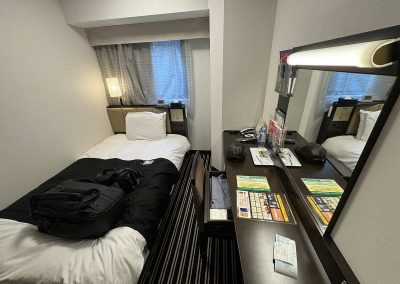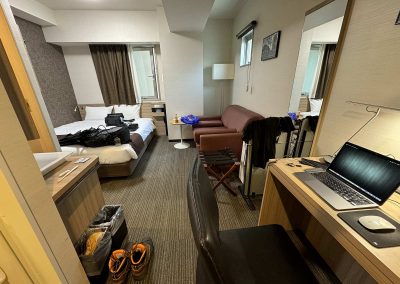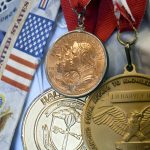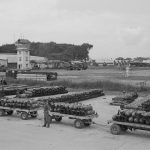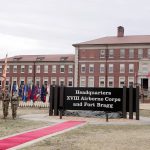
Anyone who has taken a long-distance trip has an idea about what is required to pack for the rigorous necessities of travel. When photojournalists prepare for assignments overseas it is far more complicated, especially planning the logistics from a city like Milwaukee, which is not a major air hub.
As a Milwaukee-based photojournalist, I face a unique set of challenges that dictate not just what gets packed, but also how I must operate in diverse environments. There are the usual complexities of navigating different countries, combined with the conditions of being a member of the press.
Since the easing of COVID-19 restrictions in 2022, and the start of Russia’s full-scale invasion of Ukraine, I have visited 8 countries multiple times for special assignments connected to stories from Milwaukee.
After living overseas for more than a decade, the decade that followed saw me anchored in Milwaukee with only light regional excursions. In the past 26 months, I have traveled tens of thousands of miles using a fleet of international airlines, going through security checkpoints at some airports up to a half dozen times simply to board a flight.
That process of vulnerability has honed my packing skills, and I learned a lot from each assignment about how to travel more efficiently. The unfortunate part is that experience and muscle memory do not always transfer completely to the next assignment. How I pack and travel to visit a war zone in summer is not the same as visiting memorial sites in tourist cities during the winter.
Being so distant and isolated, I have to be self-sufficient and self-contained. Maybe I can buy an adaptor from a local market, but maybe there are no markets or products of good quality. So I have to plan for the unknown, with very limited space, and some practical priorities outweigh other considerations.
Technology also keeps evolving. In the last six months, for example, iPhones changed from lighting ports to USB-C ports which unified the cable standard. New power adaptors were reduced in size from last year’s generation. So while I needed fewer cables to connect the gear, different countries use different power supplies, or have older USB ports, so various clunky adapters are still required.
Also to consider is the physical aspects of travel, and what will fit where. A flight from Milwaukee to Chicago is only about a half-hour by air. But the reality is far different. Flights from Milwaukee can often remain grounded until Chicago airspace opens. And the route is plagued by flight delays or mechanical failures. This is especially true, in my experience, from Chicago to Milwaukee. Considering one flight in the early 2000s that was repeatedly delayed, it is not an exaggeration to say that I could fly to Chicago’s O’Hare from Tokyo’s Narita faster than I could fly from O’Hare to Milwaukee’s Mitchell.
For overseas assignments, I have to travel light and that usually means I cannot bring checked luggage. I can only carry what fits in a backpack, which can make it extremely condensed and heavy. The two styles of backpacks that I use both fit with the regulations by airlines for overhead compartments. However, the smaller Milwaukee to Chicago flights never use full-sized planes that actually have regulation-sized overhead compartments.
Learning how to navigate that was stressful and took some trial and error. Ultimately I bypass flying out of or into Milwaukee at all, going directly to Chicago by car – usually an Uber, which is surprisingly affordable.
In planning for my first assignment to Ukraine, when Milwaukee’s sister city of Ukraine was brutally occupied by Russian forces, I searched the Internet for examples of how other photojournalists packed.
Those examples were enlightening, but not easy to apply for my needs. They did inform me in many ways, and started my habit to photograph my gear before leaving. Originally it was a vanity to show what I was taking to support the trip. But it evolved as a learning tool, to reference what gear before worked and what was not needed.
Even though the destinations were all very different, an evolution can be easily seen in the photos of my gear. I continually improved and minimized what I packed. Each version of packing also had a different objective. Where I was based longer I brought big power banks for charging each night. Where I was moving constantly I brought more batteries to stay powered in the field.
I brought a full-sized pro camera when the likelihood of damage to my primary was higher, like Ukraine and Türkiye. In Japan, I had a list of camera stores in each region, because it was easier to buy a new camera if needed than drag a heavy backup camera that I never used.
Obviously, the priority of a photojournalist is to take photos. And a camera is the most important tool, but far from the only one. Supporting the usage of a camera and keeping safe the images requires substantially more time and gear. If a camera is damaged or photos are lost, all the effort put into the assignment becomes pointless.
The rule of thumb for overseas assignments is redundancy. Every piece of critical equipment has a backup. This includes extra batteries, multiple memory cards, and even duplicate chargers. The idea is to be prepared for any technical failure without losing the crucial ability to take photos in the field.
Thankfully my work is not done in realtime, so I am not required to send back images for publishing immediately after I take them. However, all the images have to survive the length of the trip, which can be between two weeks to a month. This is ensured by saving a copy of photos to the Cloud. But many locations I have visited did not have fast WiFi speeds or even Internet access. So I mostly use multiple solid-state hard drives placed in different physical locations on me or my gear to avoid a catastrophic loss.
Beyond technology, personal gear is equally important. I have found several clothing brands that I trust, so I order shirts and pants like disposable tools. Some get damaged in the field, and it only takes one click on Amazon.com to replace them when I return home. The clothes I pick are worn in layers depending on the weather and climate. Rugged outer clothing have many pockets and are water-repellant. Inner clothing wicks away sweat and are quick-dry for handwashing at night. Yet everything still has to pack light for space and weight.
Also included a few reference snaps that also show the diversity of hotel conditions. For most assignments I do not think about documenting these rooms. They are utilitarian and unremarkable, but for Japan there was a noticeable difference between city and rural hotels. This lack of space impacts how and what gets unpacked.
For example, business hotels had no space to move around but offered desks for work with multiple power outlets. Scenic hotels in remote areas were amazingly opulent in the traditional Japanese style, but were not comfortable for work in because they lacked handy power outlets since tatami rooms do not have fixed beds.
Every part of my toolkit has a purpose, and a reason for how I ended up with using a particular item. It would be too extensive and unnecessary to offer all the details for how some tools became useful in certain conditions. For an assignment, I will pack and re-pack multiple times to make sure everything fits, reconsider what I am taking, add something new for a particular objective, and build muscle memory for packing. That is most important, because when processing so much in unfamiliar environments it is easy for something to get lost in the chaos. And when every single item counts, I cannot afford for anything to be lost.
It is also comforting, and a bit mechanical, to instinctively know where everything is for repacking. In Japan for the 3.11 Anniversary assignment, I was in a different hotel literally every night for a month. At the end of every day, I had to catalog thousands of images, backup the images, and then recharge the batteries of all my gear.
That also made doing overnight laundry a challenge, as there was no time to dry for the next day. But the hotels thankfully had washers and driers – the first assignment in two years that I encountered them.
For some trips, I bring a compact camera, which is small but a bit more clunky to deploy than an iPhone. But it offers better photo quality and zoom options. It is also more tourist-looking which is important when I want to avoid the extra attention that comes with using a pro camera. Plus, if a country’s security forces tackle me and take the compact camera, they do not also take my phone or pro camera.
Because I am often asked about how I pack or what I take along for my overseas photojournalism assignments, I thought sharing some of these experiences and the gear I rely on might be helpful.
Using my latest “gear photo” from February 2024 I have diagramed the equipment that I pack, without extensively drilling down into the hyper-details. There are basically 6 brands, aside from clothing, at the very heart of my collection of tools.
They all have been field-tested and are usually part of some technology ecosystem. There are specialty items made by other vendors for very specific usages, but only a handful. Otherwise, if Sony, Apple, DJI, Tenba, Peak Design, and Anker make something, you can find it in my kit.
As I learned in my own research about how to pack for distant assignments, I know that this list is very unique and most people will never have a need to clone it. But even for non-photojournalists, I hope it helps inform and offers ideas for the tools needed to simply document casual travel experiences.
Essential Gear Diagram – February 2024
Assignment Gear (A - K)
A
• Peak Design Packing Cube Medium
• Shirts, Pants, Under-Shirt
B
• Peak Design Packing Cube Small
• Sleepwear, Underwear, Socks
C
• Compact Windproof Travel Umbrella
D
• SanDisk 1TB Extreme Portable SSD
E
• Various USB Adapters + SD Card Reader
• Sony NP-BX1/M8 Lithium-Ion X Type Battery (4x)
• Sony NPFZ100 Z-series Rechargeable Battery
• Anker 240W USB-C Cables
F
• Shaving Razor + Kit
G
• Apple MagSafe Duo Charger
• Sony NPFZ100 Z-series Rechargeable Battery
• Anker USB C Charger 30W
H
• Apple Magic Mouse
• Anker 45W Wall Charger
• Anker 240W USB-C Cable (2x)
I
• Sony NPFZ100 Z-series Rechargeable Battery (4x)
• Dual USB Charger for Sony NP-FZ100 Battery
• Anker USB C Charger 30W
J
• Small Mesh Cosmetic Bag (Health Supplies)
• Motion Sickness, Cough Drops, Allergy, Ibuprofen
• Neosporin, Band-Aid, Sewing Kit, Stain Remover Pen
K
• Peak Design Travel Duffelpack 45L
• Tenba DNA 16 DSLR Backpack (alternative option)
• Apple AirTag
• Anker 45W Wall Charger (2x)
• Anker 240W USB-C Cable (2x)
Assignment Gear (L - X)
L
• Apple iPad Mini
M
• iPhone 15 Pro (Personal)
N
• iPhone 15 Pro Max (Travel)
O
• DJI Osmo Pocket 3 + Support Gear
P
• SanDisk 64GB Extreme PRO (12x)
• SD Memory Card Case
Q
• Press ID + Photojournalist Credentials
R
• Apple MacBook Air
S
• Sony RX100 VII Premium Compact Camera
T
• SanDisk 1TB Extreme Portable SSD
U
• Tenba DNA 13 DSLR Messenger Bag
• Peak Design Capture Camera Clip V3
• SanDisk 2TB Extreme Portable SSD
• Apple AirTag
• Anker Nano Power Bank
• Anker 240W USB-C Cable (2x)
V
• U.S. Passport
W
• Sony Alpha 1 Full-frame Camera
• Sony SEL24240 FE 24-240mm f/3.5-6.3 OSS Lens
X
• DJI Mic 2
© Photo
Lee Matz

